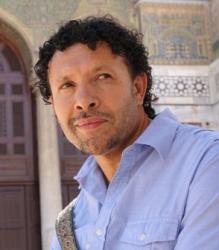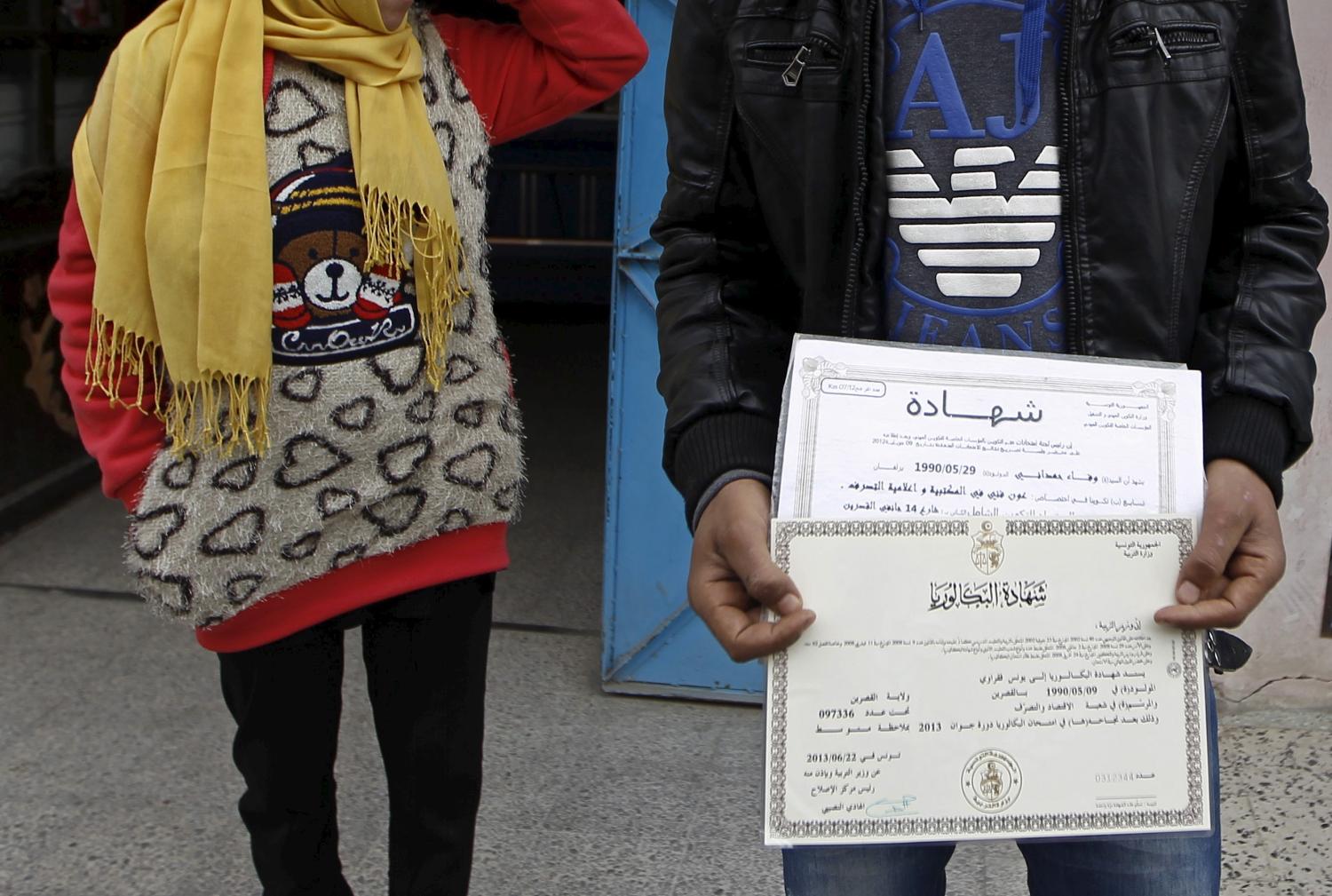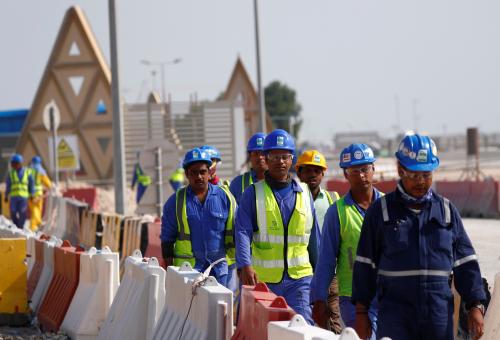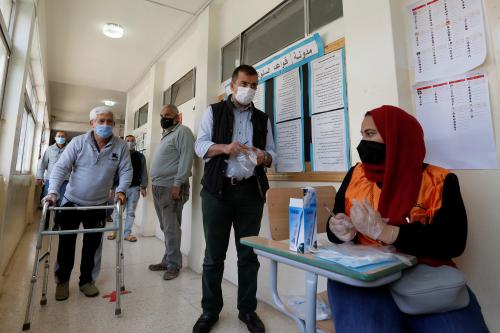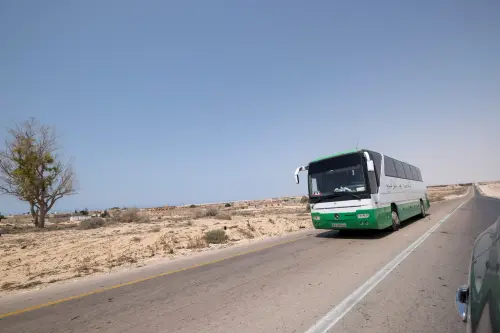Content from the Brookings Doha Center is now archived. In September 2021, after 14 years of impactful partnership, Brookings and the Brookings Doha Center announced that they were ending their affiliation. The Brookings Doha Center is now the Middle East Council on Global Affairs, a separate public policy institution based in Qatar.
Political, economic, and institutional factors have historically hampered regional development in Tunisia. Elite plans have not ensured the fair distribution of resources, both material (public funds, state and local investment, and infrastructure,) and immaterial (administrative capacity, distributive justice, and legal mechanisms). Nor have they had any effect on investors’ and politicians’ perceptions1 of the socioeconomic margins of Tunisia. While politicians pay lip service to regional development, the gap continues to widen between power holders’ declaratory policies and local communities’ expectations.
Thus, political rhetoric and state plans have fallen short of delivering on the promise of regional development as an overarching framework for minimizing deprivation.2 The result has been what is termed here “multiple marginalization,” or al-tahmish al-murakkab. Multiple marginalization, as conceived here, is a form of regional, spatial, and cumulative estrangement manifested through a state of socioeconomic and political disadvantage. The goal should be a more equal distribution not only of justice, but also of burden-sharing, namely, of alleviating deprivation and poverty throughout Tunisia.
Multiple marginalization in Tunisia has a three-fold manifestation. First, it consists of regional estrangement from the body politic qua marginalization, as the country’s South and West are relegated to a marginal status. The second level is economic and development estrangement from value-making. This hinders the ability to create goods and services and find employment. The third aspect is human estrangement, whereby people are separated from national wealth and distributive justice. Here estrangement is a loss of agency and the potential for self-regeneration qua worthiness, identity, and belonging. Examined briefly below, the interconnected indicators of multiple marginalization can include disparities in access to healthcare, natural resource wealth, clean air and water, income, employment, education, and even avenues for political participation.
This policy briefing approaches the dilemma of marginalization in Tunisia from a development perspective. It is organized as follows: first, it traces the Tunisian experience with regional development, picking up the idea of the “development of underdevelopment.” Next, it sheds light on the fault lines drawn by the marginalization of Tunisia’s interior and southern regions, highlighting their connection to disaffection and unrest in the country. Finally, it concludes with policy recommendations and suggests rethinking regional development with an integrative approach that capitalizes on local agency.
Region Key: Tunisian Governorates by Region
 Source: Brookings Doha Center, 2019
Source: Brookings Doha Center, 2019
Tunisia’s “Development of Underdevelopment”
The 2010-2011 uprising exposed pressing nation-wide development predicaments in Tunisia. Despite the country’s high scores on various development indicators, “deep-rooted distortions” of its economy, accumulating for decades, manifested in a failure to create jobs or deliver inclusive and sustainable growth within a social, political, and economic system dominated by a small coterie of elites.3
Exacerbating the development conundrum has been the problematic of regional development that, since the country’s independence, has failed to take off in Tunisia. Instead, regional development came to be defined by divisiveness. It was a top-down enterprise, micromanaged by the state. This defeated the whole purpose of promoting economic agency and collective ownership in Tunisia’s impoverished center and interior regions.
The policies enacted by Habib Bourguiba, Tunisia’s leader from 1957 to 1987, and Zine El Abidine Ben Ali, who subsequently ruled for three decades, led to the emergence of what Gunder Frank called the “development of underdevelopment.” The country became mired in skewed “metropolis-satellite” interactions: its center would exploit capital and resources from its peripheries, blocking any capacity for economic self-sufficiency or self-renewal. This locked the peripheral regions into a dynamic that exacerbated, rather than eliminated, underdevelopment.4
Neither Bourguiba nor Ben Ali followed through on their declaratory policies to ensure specifically-allocated, regenerative investments that were directed toward deprived regions. The question of the intentionality of state neglect of the center and interior regions of the country cannot be definitively, empirically verified. One view holds that such marginalization policies emanated from “localized colonialization” and “domination” in a pattern of distribution that has historically favored the North and the Center-East (Sahel) over the South and Center.5 However, such uneven development predates the postcolonial state in Tunisia. Political elites seem to have reinforced this policy after independence by downgrading those regions economically, politically, and religio-culturally via consecutive administrations from the time of Bourguiba to the present.6The Layers of Multiple Marginalization
Deliberately or not, regions such as the North-West, Center-West, South-West, and South-East have worsened overtime, becoming zones of multiple marginalization. Schemes to help employment, industry, health, and housing are noted for their absence.
Poverty and Unemployment
Poverty and unemployment are much higher in deprived regions, as indicated in the graphs below. Despite the overall reductions in national poverty rates from 23.1 percent in 2005, to 20.5 percent in 2010, and 15.2 percent in 2015,7 the regional gap measured in 2010 is still significantly wide. According to Tunisia’s National Institute of Statistics, sub-national poverty rates vary considerably: around 26 percent in the North-West and 32 percent in the Center-West, compared to around 8 or 9 percent in the Center-East and Greater Tunis regions in 2010 (Figure 1).
Unemployment rates are similarly higher in the North-West, Center-West, South-West, and South-East. As indicated in the graph below, worsening employment prospects especially stand out in the South-West and South-East, with the 2016 regional unemployment rates at 25.0 percent and 25.3 percent, respectively. By contrast, the Center-East, features the lowest levels of unemployment: 11.1 percent in 2014 and 10.0 percent in 2016. The North-East and Greater Tunis regions also demonstrate lower unemployment rates—closer to around 13 percent (Figure 2).
Figure 1: 2010 Poverty and Extreme Poverty Rates by Region
 Source: L’Institut National de la Statistique (INS) [The National Institute of Statistics8Figure 2: Tunisia Unemployment by Region in 2014 and 2016
Source: L’Institut National de la Statistique (INS) [The National Institute of Statistics8Figure 2: Tunisia Unemployment by Region in 2014 and 2016
 Source: L’Institut National de la Statistique (INS) [The National Institute of Statistics]9Access to Resources
Source: L’Institut National de la Statistique (INS) [The National Institute of Statistics]9Access to Resources
The distribution of phosphate and water are also prime examples of regional disparities. Tunisia’s phosphate basin in the southern governorate of Gafsa has been a site of protest for years. Residents rally against unemployment and demand to reap the benefits of local resources. As one protester argued, “We suffer from pollution from the phosphate production…but don’t benefit from exports. In the capital you have a nice life, but we have nothing.”10
A disproportionate share of the country’s water is also directed to the capital, coastal regions, and large cities. While Greater Tunis boasted nearly universal access to an improved water source in 2010, the rate is far lower in the Center-West and North-West regions. Despite being home to most of the nation’s freshwater supply, the North-West suffers shortages in the summer months, as the government cuts off the supply from rural and interior regions and redirects them toward major cities. Expressing indignation and feelings of injustice, protestors have disrupted pumps carrying water to the capital.11
Moreover, resources and/or income from these needy regions were siphoned off to support socioeconomic renewal in flush and well-to-do regions of the country’s North and coast. People living in rural areas such as Sajnene, in the Bizerte governorate (North-East), despite being ten times richer in water resources than the national average, encounter difficulty accessing safe drinking water. This is illustrative of the urban-rural inequality that marks every region of Tunisia, including the more developed areas such as Greater Tunis, the North-East, and the Center-East. This exacerbates the stark regional inequities.
La Société Nationale d’Exploitation et de Distribution des Eaux (SONEDE) [National Company of Exploitation and Distribution of Waters], does not operate in Sajnene (North-East), so residents may spend two hours a day to carry water for drinking.12 Only kilometers away from Sidi Barrack, the country’s second largest dam, residents of Toghzaz in Jendouba (North-West) use donkeys to transport water from public fountains and are sometimes forced to drink from reservoirs that have been certified as hazardous by SONEDE.13Health and Environmental Damage
The governorates of Tunis, Sousse, and Monastir have been consistently advantaged in the health care sector. In contrast, the governorates of Jendouba, Kairouane, Kasserine, and Sidi Bouzid were consistently “least favored” among Tunisia’s twenty-four governorates. Infant mortality, too was higher in the South (21 per thousand) and Center-West (23.6 per thousand) than the national average of 17.8 per thousand in 2009.14 Life expectancy varied between regions: 77 in Tunis and Sfax, versus 70 in Kasserine and Tatouine in 2009.15 With nearly 70 percent of specialist physicians located on the coast, the healthcare distribution problem exceeds a mere physician shortage.16
Multiple marginalization in Tunisia also spills into negative externalities of ill-managed industrial projects and irresponsible resource extraction. Ambient air pollution was responsible for 4,631 early deaths in Tunisia in 2012—from respiratory diseases, lung cancer, pulmonary and heart disease, and stroke, based on numbers from the World Health Organization.17 Notably, even pollution is more heavily concentrated in the country’s Center and South.18 For example, the Groupe Chimique Tunisien (GCT) [Tunisian Chemical Group] owns and operates a chemical plant near Salam Beach (known as Shatt al-Mawt or “Beach of Death”) in Gabes (South-East). Pollution and badly disposed waste from the chemical plant leaves the area rife with environmental damage, killing off vegetation and fish. Illnesses include lung cancer, asthma and other respiratory diseases, and osteoporosis, linked by residents to the presence of a nearby fertilizer plant.19 These health problems stem from the practice of dumping phosphogypsum (PG) into the ocean, in violation of Tunisia’s own 1975 Water Law.20Political Exclusion
Years after the Tunisian revolution, political marginalization goes hand-in-hand with the rampant economic and social marginalization in the country, particularly among Tunisia’s youth. Long-simmering discontent over social, economic, and political exclusions erupted in the first of the Arab Spring popular uprisings.
It is unsurprising then, that the level of formal political participation, such as voting in elections and political party membership, is markedly low among Tunisia’s youth cohort, aged 15-29.21 Instead, informal political participation (e.g. political protest) remains the most common mode of expressing socio-political grievances. The political exclusion of youth is deeper in the southern and interior regions of the country.22 The rural-urban divide within regions23 is also exacerbated by the coast-interior regional gap. A digital divide also contributes to sentiments of youth exclusion in the interior.24
Perceptions of the responsiveness of politicians to their needs, and thus youths’ ability to influence development, are much higher in urban (38 percent of young men and 38.9 percent for young women) compared to rural areas (11.5 percent of young men and 12.4 percent of young women).25 These attitudes mesh with widespread perceptions of corruption. Residents of regions outside Tunis see regional favoritism in both public and private investments that unfairly direct funds to Tunis and the Sahel (Center-East), rather than the country’s interior regions.26Regional Development for Post-2011 Tunisia
Regional development remains key to countering multiple marginalization and for the acceleration of local growth. Nevertheless, promoting its embeddedness in Tunisia requires stronger commitment to good governance, distributive justice, and local entrepreneurship, which benefit from locally-produced resources.
With its people-centered focus on removing obstacles to choice and constraints on agency, the UN Development Programme’s (UNDP) concept of human development can furnish the foundation for regional development. “Both a process and an outcome,” human development stems from the notion that “people must influence the processes that shape their lives”: this includes, but is not limited to, economic development.27 Poverty relates not just to income but is “multidimensional,” including access to public services and deprivation with respect to health, education, and standard of living.28 Overall, multidimensional poverty feeds into multiple marginalization. In line with the 2030 Sustainable Development Goals, sustainability is a “matter of distributional equity, both within and across generations.”29
The UN Centre for Regional Development describes regional development as the pursuit of a “balanced distribution of population and economic activities in a spatial context to attain equity and social cohesion/justice.” It should involve “participatory planning,” as well as attention to environmental and disaster risks in a “multidisciplinary and integrated approach.”30 The Organization for Economic Cooperation and Development’s (OECD) “new” approach to regional development also emphasizes tapping into local and regional assets in addition to “collective governance.” Coordination between national, regional, and local governments should privilege the latter as they also work with external stakeholders.31
Stability and social peace matter in the “new” post-2011 Tunisia. Hence, the adoption of an integrated approach should be prioritized. Tunisia has seen dire consequences for the social, political, and economic exclusion of youth in particular, highlighted in the 2016 Arab Human Development Report. A marked increase in Tunisian attempts at sea crossings toward European shores has been evident since the Gafsa protests of 2008. In 2014, 67 percent of all Tunisian migrants detained by Libyan authorities hailed from Tunisia’s Center and South.32
Protest activity is also ongoing in the country’s deprived regions. In Jendouba (North-West,) for instance, local residents and farmers recently protested the state’s failure to provide local access to abundantly available water.33Protests have repeatedly disrupted phosphate extraction in the Center-West over the past six years, resulting in losses of over $180 million and a significant trade deficit. Residents of Gafsa, in the country’s Center-West, have objected to the state phosphate company’s34 employment practices in a governorate where the unemployment rate is 28.3 percent; negotiations between unions and the current government have been rocky.35 Through months of sit-ins and protests that halted oil and gas production, residents of Tataouine and Kebili ceased demonstrations only after the Prime Minister Youssef Chahed’s government signed an agreement with protestors promising jobs in the oil companies, a development fund, and environmental projects.36
The radicalization of Tunisian youth has also been frequently linked to marginalization. In a ricocheting national-regional-global dynamic, groups such as Ansar al-Sharia operate along border regions such as Ben Guerdane, in the southern Medenine governorate.37 The recruitment of Tunisian fighters from marginalized regions by the Islamic State group, and other militias in Syria and Libya, has also been well documented.38Avoiding Fault Lines Through Development Policy
Regional development for post-2011 Tunisia is taken here as the activation of a state-initiated push toward regional balance in the distribution of material and immaterial resources. It necessitates special attention to spatially, socially, politically, and economically marginalized groups to ensure self-renewing economic productivity. It must also include processes inclusive of local populations and communities through decentralization, as well as the involvement of formal and informal, national and international actors.
Hence regional development can be rethought and restructured as an integrative mode of center-margin, formal-informal, local-national, national-international, and public-private synergies.
Policymakers must find the right instruments, support, and funds to enact appropriate and effective policies. Such is the message of the populace, exemplified by the Tataouine protest mantra al-rakh la.39The phrase connotes relentlessly seeking distributive justice and staying the course to demand access and opportunity, forging a way out of multiple marginalization, toward freedom and dignity. They should work unceasingly to activate and normalize the constitutional provisions40 that institutionalize its obligation to more balanced and equitable distribution of resources. Failing that makes the reproduction, rather than the resolution, of multiple marginalization an inevitability.
Policy Recommendations
Inclusive growth: Tunisia’s policymakers do not have to start from a clean slate. To be consistent with goals such as those found in the 2016 UN Human Development Report, inclusive growth must be adapted to suit local reality, with a particular focus on youth.41 For, bringing deprived regions into the development fold must be geared toward: “creating productive and remunerative employment opportunities in sectors where poor people live and work; enhancing inclusion in productive resources, especially finance, [and] investing in human development priorities relevant to those who are left out” through a range of policy interventions.42Regional development fund: Inclusive growth can be aided by policies that adopt measures of positive discrimination.43 A regional development fund (financed by a repository of national, international44 and private aid) can serve as a compensatory mechanism, independent of the national budget. This redresses fairness in the overall development process and reduces dependency on dwindling state handouts. It includes social protection measures and benefits45 for specific groups (e.g. women, the unemployed, youth, and those suffering from underdevelopment-related health ailments). Fiscally, this means the redirection of a small percentage of proceedings from national wealth. There should be a special development fund, also linked to efforts toward the Sustainable Development Goals in Tunisia.46 Funding and programs, singling out youth unemployment,47 for instance, can be enriched through international partnerships, as with the UNDP.
Regional representation and participation: Whilst decentralization is often argued to be a panacea for problems of underrepresentation, it might also become a recipe for systemic malfunction via “budgetary slippage and inefficiency.”48 Recent experiences in other European and Asian contexts demonstrate that decentralization is not without risks. Legion illustrations noted in the examples of Turkey, Greece, Denmark, and Japan, for instance, point to the excessive atomization of budgetary resources and personnel, as well as the duplication of responsibilities between national and sub-national bureaucracies.49 Bearing these challenges in mind, the creation of a new chamber in the Tunisian parliament that represents regions may be in order. This can be another mechanism that supports the momentum for decentralization, solidified in this year’s municipal elections.50 Such a move would be consistent with constitutional provisions for enacting local government, as stipulated in articles 133-136.51
How exactly the municipalities, boasting a new popular mandate, will navigate the problem of regional representation with respect to the country’s political center has yet to be determined. The chamber mentioned above, potentially a senate-like representative body, may be a modality reconciling local/regional with national/central needs and interests. Such an institution can also facilitate setting up accountability and good practice indicators, developing a code of development practice ethics, with publicly available information about respective development regions. Activating the right to information52to “hol[d] social institutions publicly and mutually accountable” with respect to policies seeking to eliminate exclusions,53 is paramount.
Mainstreaming regional development: Creating geographical and demographic poles of growth that accelerate both intra and cross-regional development is important. Regional growth trailblazers Sfax can serve as a hub for neighboring governorates such as Sidi Bouzid, Kasserine, and Kairouan. This could help create entrepreneurial, industrial, agricultural, and human synergy and cross-regional, cross-municipal learning that allows for a kind of internal trickle-down effect from the richer to the poorer states.
“Greening Development”: It is necessary to reverse the adverse effects of “development of underdevelopment”, namely, environmental degradation and the spread of chronic diseases (e.g. osteoporosis) related to chemical production and mining. This is especially true since the constitution notes the intergenerational responsibility attached to environmental awareness and protection.54Conclusion
Various political, economic, and institutional factors have contributed to the rise of regional inequality in Tunisia. This division likely started during Tunisia’s colonial period and continued into the policymaking of the post-independent state. The fault lines that have divided the country between a more prosperous coastal area in the North (including Greater Tunis) and deprived regions in the Center and South have led to multiple marginalization. More specifically, regions such as the North East, Greater Tunis, and Center East are privileged over the North West, Center West, and the entire South.
Multiple marginalization encompasses three manifestations of alienation including regional/spatial estrangement, economic and development estrangement, and finally, human estrangement. While this paper focuses on regional inequalities in Tunisia, it also sheds light on rural-urban inequalities through the country, including in the more advantaged regions of the North. In other words, the development problematic in Tunisia, while especially acute in deprived regions, remains a nation-wide problem.
Tunisia’s development policies have not contributed to a balanced distribution of resources throughout the country. Existing development processes seem to be paying relatively scant attention to the specific needs of the disadvantaged regions that are bogged down in multiple marginalization. To illustrate the multifarious nature of this marginalization, as well as the acute level of regional inequality, this policy briefing discusses poverty and unemployment, the distribution of natural resource wealth and clean water, access to the health care sector, and lastly, environmental damage and health effects.
Tunisia’s record with international aid development is longstanding. Nevertheless, tailored development strategies are needed, bridging the gap between the agendas of national and local stakeholders: to succeed as a material-moral contributor, tailor-made development must tackle multiple marginalization head on. Failing that, regional development will not be conducive to upgrading deprived regions from low to middle- income status.
The central government must commit to offering serious compensation to mitigate the consequences of multiple marginalization. To do so, it must collaborate with deprived regions and the international donor community to promote inclusive development practices. The aim should be to seek assistance in cultivating self-regenerating regional development; political decentralization that helps ensure greater regional representation at the national level; and clean air and energy systems. Such policies will also help stop environmental and health degradation caused by uneven postcolonial development detrimental to man and nature.
-
Footnotes
- Moody’s Investors Service lowered Tunisia’s credit rating earlier this year. See Ahmed Feteha, “Tunisia’s Economy Takes Another Hit as Moody’s Cuts Rating,” Bloomberg, March 15, 2018, https://www.bloomberg.com/news/articles/2018-03-15/tunisia-s-economy-takes-another-hit-as-moody-s-cuts-rating.
- “Deprivation” is a commonly used term in UN development discourse. See, for instance, United Nations Development Programme (UNDP), “Human Development Report 2016: Human Development for Everyone,” 2016, 1-5, http://hdr.undp.org/sites/default/files/2016_human_development_report.pdf.
- World Bank Group, “Tunisia: Systematic Country Diagnostic,” 2015, xiii-xiv, https://openknowledge.worldbank.org/bitstream/handle/10986/23112/102298.pdf?sequence=5&isAllowed=y.
- Andre Gunder Frank, “The Development of Underdevelopment,” Monthly Review, 18, No. 4, (September 1966), http://s3-euw1-ap-pe-ws4-cws-documents.ri-prod.s3.amazonaws.com/9781138824287/ch10/1._Andre_Gunder_Frank,_The_Development_of_Underdevelopment,_1966.pdf, accessed May 15, 2018.
- Al-Salehi, Al-Saghir, Al-Isti’maar al-Dakhili wal Tanmiyah ghair al-Mutakaafi’ah: Mandhoomat al-‘Tahmish’ fi Tunis Namoodhajan [Internal Colonization and Unequal Development: The Archeology of ‘Marginalization’ in Tunisia] (Tunis: Al-Sharikah al-Tunisyyah lil-Nashr, 2017).
- Ibid.
- “The World Bank in Tunisia: Political-economy context” The World Bank, accessed November 19, 2018, https://www.worldbank.org/en/country/tunisia/overview.
- National Institute of Statistics, “Measuring Poverty, Inequalities and Polarization in Tunisia: 2000-2010,” November 2012, 16, https://www.afdb.org/fileadmin/uploads/afdb/Documents/Project-and-Operations/Measuring_Poverty_Inequalities_and_Polarization_in_Tunisia_2000-2010.PDF.
- National Institute of Statistics Database, “General Census of the Population and the Household 2014 by Governorates,” accessed June 3, 2018, http://regions.ins.tn/TNCNSRPRGVN2016/general-census-of-the-population-and-the-household-2014-by-governorates?indicator=1000280-unemployment-rate&governates=1000000-tunisia; National Institute of Statistics Database, cited in Akher Khabar Online, “Al-Ma’had al-Watani lil-Ihsaa’: Tataouine Tatasaddar al-Qa’imah, wa hadhihi nisbat al-batalah hasab al-wilayat” [INS: Tataouine Tops the List, and These are the Unemployment Rates by Governorate], accessed November 16, 2018, http://www.akherkhabaronline.com/ar/%D9%85%D8%AC%D8%AA%D9%85%D8%B9/9364/%D8%A7%D9%84%D9%85%D8%B9%D9%87%D8%AF-%D8%A7%D9%84%D9%88%D8%B7%D9%86%D9%8A-%D9%84%D9%84%D8%A5%D8%AD%D8%B5%D8%A7%D8%A1-%D8%AA%D8%B7%D8%A7%D9%88%D9%8A%D9%86-%D8%AA%D8%AA%D8%B5%D8%AF-%D8%B1-%D8%A7%D9%84%D9%82%D8%A7%D8%A6%D9%85%D8%A9-%D9%88%D9%87%D8%B0%D9%87-%D9%86%D8%B3%D8%A8%D8%A9-%D8%A7%D9%84%D8%A8%D8%B7%D8%A7%D9%84%D8%A9-%D8%AD%D8%B3%D8%A8-%D8%A7%D9%84%D9%88%D9%84%D8%A7%D9%8A%D8%A7%D8%AA.html.
- See Ulf Laessing, “Tunisia Phosphate Exports Halted by Job Protests,” Reuters, February 16, 2018, https://www.reuters.com/article/us-tunisia-protests/tunisia-phosphate-exports-halted-by-job-protests-idUSKCN1G01XP.
- See Cody Pope, “Tunisia’s Thirst Uprising: A Nation on Edge,” Circle of Blue, October 27, 2016, http://www.circleofblue.org/2016/africa/a-nation-on-the-edge/.
- Milutinović, S., R. Laušević, J. Petersen-Perlman, M. Bartula, A. Solujić “Local Water Security Assessment for Improved Water Management in Selected Countries in the Middle East and North Africa (MENA) Region,” WGC Initiative, Regional Environmental Center, May 2016, 290-293, http://documents.rec.org/publications/Study_MENA.pdf.
- “Tunisia’s Parched North,” Nawaa, December 29, 2015, https://nawaat.org/portail/2015/12/29/tunisias-parched-north/.
- African Development Bank, “Economic Brief: What Qualities Should be Implemented to Address Inequalities in Healthcare in Tunisia?” 2014, 6, https://www.afdb.org/fileadmin/uploads/afdb/Documents/Publications/Economic_Brief_-_What_policies_should_be_implemented_to_address_inequalities_in_health_care_in_Tunisia.pdf.
- Ibid, 2.
- Ibid.
- World Health Organization, “Ambient Air Pollution: A Global Assessment of Exposure and Burden of Disease,” 2016, 71, http://apps.who.int/iris/bitstream/handle/10665/250141/9789241511353-eng.%20pdf?sequence=1.
- Ranking in the highest pollution category (over 35 particle matters 2.5 micrometers in aerodynamic diameter), versus the Northern parts of the country (in the 25-35 particle matter category). See Health Effects Institute, “State of Global Air 2018. Special Report,” 2018, 3, https://www.stateofglobalair.org/sites/default/files/soga-2018-report.pdf.
- H. Abdelqader, “Al-Talawwuth Ma’saah Insaniyyah fi Gabes al-Tunisiyyah” [Pollution is a Human Tragedy in Tunisia’s Gabes], Al Jazeera, December 28, 2014, http://www.aljazeera.net/news/reportsandinterviews/2014/12/28/%D8%A7%D9%84%D8%AA%D9%84%D9%88%D8%AB-%D9%85%D8%A3%D8%B3%D8%A7%D8%A9-%D8%A5%D9%86%D8%B3%D8%A7%D9%86%D9%8A%D8%A9-%D9%81%D9%8A-%D9%82%D8%A7%D8%A8%D8%B3-%D8%A7%D9%84%D8%AA%D9%88%D9%86%D8%B3%D9%8A%D8%A9.
- Eric Goldstein, “Tunisia’s legacy of pollution confronts democratic politics,” Open Democracy, May 23, 2014, https://www.opendemocracy.net/north-africa-west-asia/eric-goldstein/tunisia%E2%80%99s-legacy-of-pollution-confronts-democratic-politics.
- World Bank Group, “Tunisia: Breaking the Barriers to Youth Inclusion,” 2014, 19, http://www.worldbank.org/content/dam/Worldbank/document/MNA/tunisia/breaking_the_barriers_to_youth_inclusion_eng.pdf.
- Ibid, xv.
- Pockets of political and economic marginalization can also be discerned among the disaffected in the outskirts of urban areas such Douar Hicher in Manouba. See Taylor Luck, “In Tunis Suburb, A Revolutionary Demand: Jobs, not Freedoms,” February 20, 2018, Christian Science Monitor, https://www.csmonitor.com/World/Middle-East/2018/0220/In-Tunis-suburb-a-revolutionary-demand-jobs-not-freedoms.
- World Bank Group, “Tunisia: Breaking the Barriers to Youth Inclusion,”13.
- Ibid, 15.
- Ibid, 33.
- United Nations Development Programme (UNDP), “Human Development Report 2016: Human Development for Everyone,” 2016, 2, http://hdr.undp.org/sites/default/files/2016_human_development_report.pdf.
- Ibid, 54.
- Ibid, 9.
- “Regional Development,” United Nations Centre for Regional Development, http://www.uncrd.or.jp/index.php?menu=368, accessed May 20, 2018.
- “Regional Development Policy,” Organization for Economic Development and Cooperation (OECD), http://www.oecd.org/cfe/regional-policy/regionaldevelopment.htm, accessed May 20, 2018.
- United Nations Development Programme, “Arab Human Development Report 2016: Youth and the Prospects for Development in a Changing Reality,” 2016, 156, http://www.arab-hdr.org/reports/2016/english/AHDR2016En.pdf.
- “Jendouba: Ihtijaj al-Falaheen bi Wadi el Mleez li Ghiyab al Maa’” [Jendouba: Farmers Protest Lack of Water in Mleez Valley], Nessma TV, April 21, 2017, https://www.nessma.tv/rubrique/%D8%A3%D8%AE%D8%A8%D8%A7%D8%B1-%D8%A7%D9%84%D8%AC%D9%87%D8%A7%D8%AA/%D8%AC%D9%86%D8%AF%D9%88%D8%A8%D8%A9-%D8%A7%D8%AD%D8%AA%D8%AC%D8%A7%D8%AC-%D8%A7%D9%84%D9%81%D9%84% D8%A7%D8%AD%D9%8A%D9%86-%D8%A8%D9%88%D8%A7%D8%AF%D9%8A-%D9%85%D9%84%D9%8A%D8%B2-%D9%84%D8%BA%D9%8A%D8%A7%D8%A8-%D8%A7%D9%84%D9%85%D8%A7%D8%A1-4518.
- The state phosphate company is called La Compagnie des Phosphates de Gafsa (CPG).
- Hanen Jabli, “Protests in Tunisia’s Phosphate Regions Threaten Economy,” Al-Monitor, March 21, 2018, https://www.al-monitor.com/pulse/originals/2018/03/protests-appointments-phosphate-company-affect-production.html.
- Reuters, “Tunisia Gas Field Protesters Reach Deal, Production to Restart – Government,” June 16, 2017, https://www.reuters.com/article/us-tunisia-protests/tunisia-gas-field-protesters-reach-deal-production-to-restart-government-idUSKBN19710.
- Tarek Amara and Patrick Markey, “Border Attack Feeds Tunisia Fears of Libya Jihadist Spillover,” March 13, 2016, Reuters, https://www.reuters.com/article/us-tunisia-security-idUSKCN0WF072.
- Geoffrey Macdonald and Luke Waggoner, “Why are so Many Tunisians Joining the Islamic State?” Washington Post, January 27, 2017, https://www.washingtonpost.com/news/monkey-cage/wp/2017/01/27/why-are-so-many-tunisians-joining-the-islamic-state/?noredirect=on&utm_term=.85ba7e222554.
- A. Umayrah, “Al-rakh la: ‘Indama yatasa’al al-Tunisiyoon ‘an tharwatihim al-tabi’iyyah” [Al-rakh la: When Tunisians Ask Questions About their Natural Resources], Noon Post, May 3, 2017, https://www.noonpost.org/content/17834.
- Article 12 of Tunisia’s constitution states: “The state shall seek to achieve social justice, sustainable development and balance between regions based on development indicators and the principle of positive discrimination.” Article 136 stipulates additional funds for local governments in pursuit of “solidarity,” including the earmarking of “a portion” of natural resource revenues to be used for regional development.
- It may be tempting to adopt World Bank directives promoting the internal mobility of workers to urban areas, such as the capital. See World Bank, “World Bank Annual Report 2009: Year in Review,” 2009, 158-169, http://siteresources.worldbank.org/EXTAR2009/Resources/6223977-1252950831873/AR09_Complete.pdf. However, as some critics note, “spatially-blind” development prescriptions favoring the growth of urban areas and megacities may reflect success stories in Western countries but may not be suitable for developing contexts where place matters. Complications from encouraging internal mobility include the too-rapid growth and “congestion” of large cities, as well as excessive competition over already stretched public services and resources. For example, see Fabrizio Barca, Philip McCann, and Andres Rodriguez-Pose, “The Case for Regional Development Intervention: Place-Based versus Place-Neutral Approaches,” Journal of Regional Science 52, no.1 (January 31, 2012): 134-152, https://doi.org/10.1111/j.1467-9787.2011.00756.x.
- UNDP, “Human Development Report 2016,” 106.
- Thus, the World Bank’s dismissal of investments of service infrastructure in deprived regions as “place-based entitlements” that must be avoided is short-sighted (see World Bank, “World Bank Annual Report 2009,” 169). The compound marginalization of Tunisia can be mitigated by targeting the country’s south and interior, rather than re-routing its subalterns to cities that may not be able to contain them.
- For instance, the European Neighborhood Instrument supporting regional development in Tunisia. See “European Neighborhood Policy and Enlargement Negotiations: Tunisia,” European Commission, accessed August 15, 2018, https://ec.europa.eu/neighbourhood-enlargement/neighbourhood/countries/tunisia_pl.
- Ibid, 16.
- E.g. to implement UN recommendations from the 2017 UN Periodic Review on progress toward the Sustainable Development Goals. See UNDP, “The SDGs and Human Rights: Tunisia,” May 2017, http://www.arabstates.undp.org/content/dam/rbas/doc/UPR/Tunisia.pdf.
- “Employment Generation for Young People in Tunisia (Youth Employment Generation Programme in Arab Transition Countries),” UNDP, accessed November 16, 2018, http://www.undp.org/content/undp/en/home/ourwork/development-impact/south-south-cooperation/featured-stories/featured-stories2211.html
- OECD, “Tunisia: A Reform Agenda to Support Inclusiveness and Competitive Growth,” March 2015, https://www.oecd.org/economy/Tunisia-a-reform-agenda-to-support-competitiveness-and-inclusive-growth.pdf, 43.
- Ibid.
- Tarek Amara, “Independent Candidates Get Most Votes in Tunisia’s Municipal Election,” Reuters, May 8, 2018, https://www.reuters.com/article/us-tunisia-election/independent-candidates-get-most-votes-in-tunisias-municipal-election-idUSKBN1I92DW.
- These articles require the free election of municipal councils with powers delegated and resources allocated by the central government. Article 141 of the Tunisian constitution further gives the umbrella High Council of Local Authorities “jurisdiction to consider issues related to development and regional balance” and provides input on draft legislation related to planning, budgetary, and financial matters.
- Article 132 of Tunisia’s constitution.
- UNDP, “2016 Human Development Report,” 132.
- See Articles 44 and 45 of the Tunisian constitution. Article 129 establishes the Commission for Sustainable Development and the Rights of Future Generations.
The Brookings Institution is committed to quality, independence, and impact.
We are supported by a diverse array of funders. In line with our values and policies, each Brookings publication represents the sole views of its author(s).
